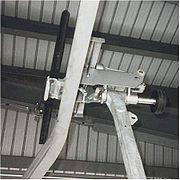
Cable grip
Encyclopedia

Vehicle
A vehicle is a device that is designed or used to transport people or cargo. Most often vehicles are manufactured, such as bicycles, cars, motorcycles, trains, ships, boats, and aircraft....
by attaching to a wire cable (also called wire rope) running at a (relatively) constant speed. The vehicle may be suspended from the cable, as in the case of aerial lift
Aerial lift
An aerial lift is a means of transportation in which cabins, cars, gondolas or open chairs are hauled above the ground by means of one or more cables.Types of aerial lifts include:...
s such as a gondola lift
Gondola lift
A gondola lift is a type of aerial lift, normally called a cable car, which is supported and propelled by cables from above. It consists of a loop of steel cable that is strung between two stations, sometimes over intermediate supporting towers. The cable is driven by a bullwheel in a terminal,...
(télécabine), may be guided by rails, as in a cable traction railway
Cable car (railway)
A cable car or cable railway is a mass transit system using rail cars that are hauled by a continuously moving cable running at a constant speed. Individual cars stop and start by releasing and gripping this cable as required...
, or may be self-guiding, as in a button lift. Typically, multiple vehicles will use the same cable; where just one or two vehicles are in use they will tend to be attached to the cable permanently (e.g. funicular
Funicular
A funicular, also known as an inclined plane or cliff railway, is a cable railway in which a cable attached to a pair of tram-like vehicles on rails moves them up and down a steep slope; the ascending and descending vehicles counterbalance each other.-Operation:The basic principle of funicular...
s).
While the cable grips used in the original cable railways were manually operated, requiring considerable skill and strength, modern cable grips tend to be automatic. Given that the cable runs at a relatively constant speed, accelerating the vehicle to match the speed of the cable presents a technical difficulty; possible methods are to apply the grip gradually, to accelerate the vehicle (e.g. by guiding wheels) prior to applying the grip, or to use a sprung linkage between the grip and the vehicle. Also, the cable needs to be able to handle friction from the grip and increased load while the vehicle is accelerating.
The Eppelsheimer Bottom Grip
This is the type of grip used in the cable cars of San Francisco. The grip is attached to the lead truck of the car (or both trucks, in the case of double-ended cars), and is a field-replaceable unit. While there have also been side grips and even top grips, the sheer number of rope changes, crossings, and "let-go" curves make a bottom grip, i.e., one in which the jaws open directly downward, the most practical type of grip.The operating lever raises and lowers the center plate of the grip, which in turn operates the jaws. With the lever fully forward, the grip is open, and the cable is free to fall out (necessary when the cable crosses under another line, as well as at the ends of lines, and at "let-go" curves). With the cable lifted into the jaws, the operating lever is pulled back, forcing the jaws between two fixed rollers, and capturing the cable between the grip's replaceable mild-steel dies (but without applying pressure). To start moving the car, the operating lever is pulled back further, squeezing the cable between the dies.

